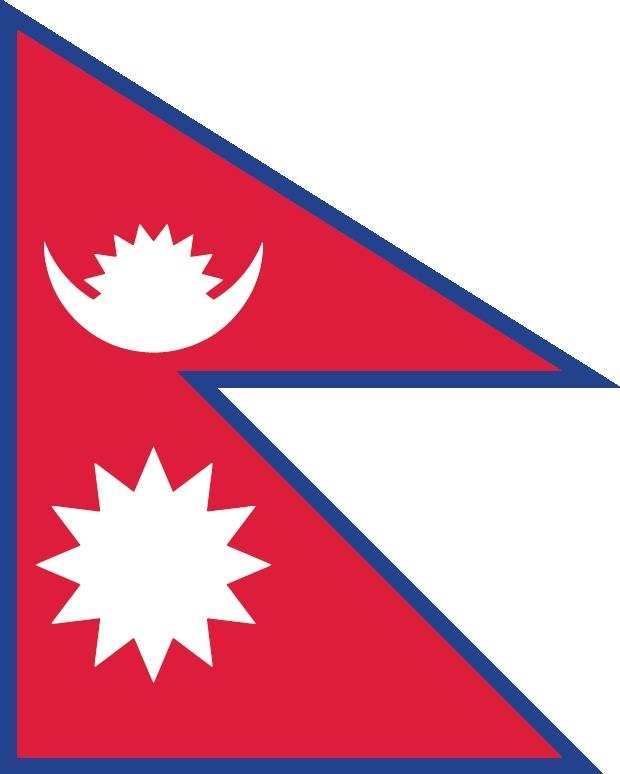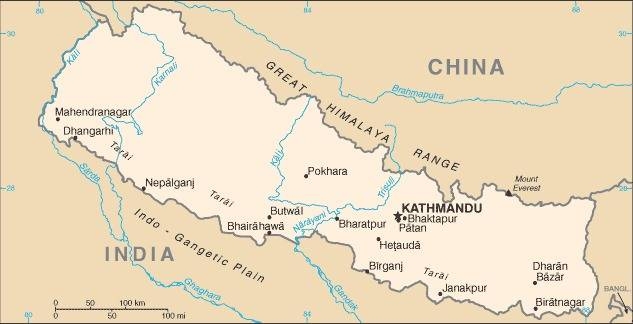156 Nepal

Crimson red with a blue border around the unique shape of two overlapping right triangles. The smaller, upper triangle bears a white stylized moon and the larger, lower triangle displays a white 12-pointed sun. The color red represents the rhododendron (Nepal’s national flower) and is a sign of victory and bravery, the blue border signifies peace and harmony. The two right triangles are a combination of two single pennons (pennants) that originally symbolized the Himalaya Mountains while their charges represented the families of the king (upper) and the prime minister, but today they are understood to denote Hinduism and Buddhism, the country’s two main religions. The moon represents the serenity of the Nepalese people and the shade and cool weather in the Himalayas, while the sun depicts the heat and higher temperatures of the lower parts of Nepal. The moon and the sun are also said to express the hope that the nation will endure as long as these heavenly bodies.
Flag courtesy of the CIA World Factbook

Map courtesy of the CIA World Factbook

A view of temples in the area of Durbar Square in the historic center of Kathmandu, capital of Nepal. This photograph was taken before the devastating earthquake of 2015, during which many of these buildings were severely damaged or destroyed.
Photo courtesy of the CIA World Factbook
Government
According to Britannica, although reforms in the 1950s began to move the kingdom toward a democratic political system, the crown dissolved parliament in 1960 and subsequently banned political parties. Thereafter, Nepal became only nominally a constitutional monarchy, and the constitution of 1962 (amended 1967, 1976, and 1980) effectively gave the king autocratic control over a multitiered system of panchayats (local bodies, or councils). In the 1980s, political restrictions were eased, and organizations such as the Nepali Congress Party, the Communist Party of Nepal, numerous small left-leaning student groups, and several radical Nepalese antimonarchist groups were allowed to operate more or less openly. Political parties, however, were not again legalized until 1990, when nationwide unrest forced King Birendra to accept the formation of a multiparty parliamentary system.
A new constitution promulgated on November 9, 1990, greatly reduced the power of the monarchy. The king remained the head of state, but effective executive power was given to the Council of Ministers, headed by the prime minister. Appointed by the king, the prime minister was required to be either the leader of the majority party in the House of Representatives (the lower house of parliament) or, if there was no majority party, a representative who could form a coalition majority.
The king was constitutionally also a part of parliament and was charged with giving assent to bills that had been passed by both legislative chambers, the House of Representatives and the National Council (the upper house). The House of Representatives consisted of 205 members popularly elected to five-year terms. The 60 members of the National Council held six-year terms; 10 were nominated by the king, 35 were elected by the House of Representatives (of which 3 had to be women), and 15 were selected by an electoral college. The constitution gave the House of Representatives considerably more power than the National Council.
All Nepalese citizens age 18 and older are eligible to vote. Because most voters in Nepal are illiterate, candidates largely have been chosen by party symbol (e.g., a tree for the Nepali Congress Party and a sun for the United Marxist-Leninist Party of Nepal). Some voters, moreover, have had to travel long distances, in some cases for hours along mountain paths, in order to reach a polling station.
Prior to 1990 the country was divided for administrative purposes into 5 development regions, 14 zones, and 75 districts; in addition there were corresponding regional, zonal, and district courts, as well as a Supreme Court. The 1990 constitution mandated the elimination of the regional and zonal courts, which were to be replaced by appellate courts. The administrative divisions themselves continued to exist as provisional units.
The early 21st century was a tumultuous yet transformative period in Nepal’s governmental history. A Maoist insurgency that had been gaining strength since the late 1990s demanded not only the election of a constituent assembly to draft a new constitution but also the abolition of the monarchy. As the insurgents negotiated with the government, tensions escalated into violence. Following intermittent peace talks, abortive cease-fires, dissolution and reconstitution of the House of Representatives, and major abrogation of the king’s authority, the Maoists and the government finally agreed to the drafting of an interim constitution, promulgated in January 2007, and the formation of an interim administration. Elections for a constituent assembly of some 600 members were held in April 2008, and the following month the monarchy was indeed dissolved and Nepal declared a republic.
The country continued to operate for several more years under an interim constitution that provided for a unicameral legislature and a Council of Ministers, with most of the power vested in the prime minister. Protracted negotiations finally produced a new permanent constitution in 2015, which was approved by the legislature and promulgated on September 20. The document established a secular federal-style republic consisting of seven administrative regions and a bicameral legislature. A president would be head of state, and the Council of Ministers, led by the prime minister, would continue as head of government.
Civil Aviation Authority of Nepal (CAAN)
In 1957, the Department of Civil Aviation was formally established under the then Ministry of Work, Communications and Transport of the Government of Nepal. The statutory regulations regarding civil aviation were introduced under the Civil Aviation Act, 1959 (2015 BS). Nepal obtained the membership of ICAO in 1960.
The Government of Nepal introduced its first ever Civil Aviation Policy in 2050 B.S. (1993 A.D.). This policy made the provision of transformation of Department of Civil Aviation into an autonomous Civil Aviation Authority. Accordingly, Civil Aviation Authority of Nepal (CAAN) was established as an autonomous regulatory body on 31 December 1998 under Civil Aviation Act, 1996. CAAN is the regulator of civil aviation as well as the service provider in the areas of Air Navigation Services and Aerodrome Operations.
Airspace
SkyVector – Google Maps – ADS-B Exchange
ICAO countries publish an Aeronautical Information Publication (AIP). This document is divided into three parts: General (GEN), En Route (ENR) and Aerodromes (AD). ENR 1.4 details the types of airspace classes they chose to adopt from classes A through G.
Drone Regulations
Advanced Air Mobility (AAM) Regulations & Policies
Advanced Air Mobility (AAM) News
None found by the author.
However, should you, the reader, happen to stumble across something to the contrary, please email the author at FISHE5CA@erau.edu and you may be mentioned in the ACKNOWLEDGEMENTS section of this book by way of thanks for contributing to this free eBook!
Short Essay Questions
Scenario-Based Question
You have been hired by a Drone Startup Company. Your boss has immediately assigned this job to you.
They need you to prepare a one-page memo detailing the legalities of using a drone to film above Durbar Square, pictured above.
They need you to mention any national laws and local ordinances.
They specifically want to know what airspace (insert pictures) you will be operating in and whether or not you need an airspace authorization.
Does it matter whether or not you are a citizen of the country?
Lastly, there is a bonus for you if, as you scroll through this chapter, you find any typos or broken links!
Short Essay Questions
- What are the drone categories?
- How is registration addressed?
- How is remote ID addressed?
- What are the model aircraft rules?
- What are the commercial drone rules?
- Are there waivers or exemptions to the rules? If so, for what?
- Would you share a link to an interactive airspace map?
- How is BVLOS addressed?
- How can you fly drones at night?
- How can you fly drones over people?
- Where do you find drone NOTAMs?
- What are the rules for drone maintenance?
- What are the rules for an SMS program?
- What are some unique rules not mentioned above?
- What are the C-UAS rules?
- What are the AAM rules?

